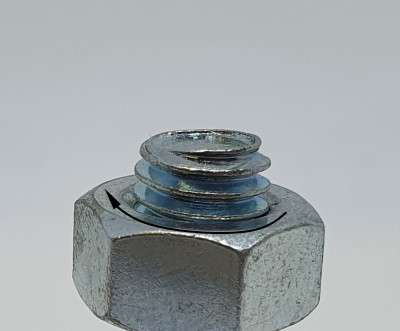- Metric Thread
- Metric Thread - Bolt Torque table
- Metric Thread - Pitch
- Metric Thread - Tap Drill table
- Metric Thread - Clearance Hole table
- Metric Fine Thread - Bolt Torque table
- Metric Fine Thread - Pitch
- Metric Fine Thread - Tap Drill table
- Metric Wrench Sizes
- Sheet Metal Screws Pilot Hole Sizes
- Cable Gland Sizes
- Trapezoidal Thread Sizes
- Cutting Metric Thread
- Inch Thread
- The Screw
- Drill correctly
- Which Dowel
- Materials
- Language
In which direction to unscrew the screw?
Often you are not sure in which direction you have to unscrew a screw or nut. However, there are a few simple possibilities that can help you here.
In principle, you need to know that 99% of all screws have a right-hand thread. Only a very small proportion of screws have a left-hand thread.
We will now show you what characteristics the threads have and how you can distinguish between them.
Right-hand thread - unscrew screw Direction

The picture on the top left shows a nut with a right-hand thread. This can also be seen from the fact that the threads rise towards the top right.
If you want to screw on a right-hand thread, you have to turn counterclockwise, i.e. to the left. In the pictures, the direction of rotation is marked by an arrow.
The picture below shows a hexagon head screw, also with a right-hand thread. Here, too, you have to loosen the screw counterclockwise. See the arrow in the picture.
Left-hand thread - unscrew screw Direction

The picture on the left shows a screw with a left-hand thread. This can also be seen from the fact that the threads rise to the top left.
Screws with left-hand threads are used where the screw connection rotates constantly to the right. The left-hand thread prevents the screw connection from loosening by itself.
If you want to screw on a left-hand thread, you have to turn clockwise, i.e. clockwise. The direction of rotation is indicated by an arrow in the picture.
An example is the left-hand bicycle pedal. To prevent the left pedal from loosening by itself, it is equipped with a left-hand thread and the right pedal with a right-hand thread.
Screw is tight and somewhat corroded (rusted)

Creep oils
If a bolt or nut is very tight and somewhat corroded (rusted), a little penetrating oil can often help to loosen the bolt. Penetrating oils are special oils that have a very low viscosity and can
penetrate very small cracks and crevices through capillary action. In this way, the penetrating oil can get into the smallest gaps in screwed connections and threads. However, the penetrating oil
should be left to work for some time so that it has time to penetrate into the gaps. The reaction time can last several hours, depending on the workpiece and the screw connection.
